From the archeological notebook of Archon Niniri Niri.
Weaponry:
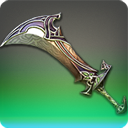
The Ancient Sword: Perhaps the most fascinating weapon found within the Stone Vigil, this blade is not of Ishgardian or even Old Ishgardian make, but instead fits with all prior archeological and scholarly findings on blades crafted in the Third Astral Era, likely by the early Allagan Empire. These blades boast intricate carvings across their form, used to channel aether across the blade and improve its cutting power. How exactly it came to be in the Vigil is difficult to say, but it may have been uncovered by, and then handed down as a relic of a family, perhaps even within House Haillenarte.
Etymology Notes: The ancient sword is a recurrent blade in the Final Fantasy franchise, typically being defined by its ability to confer negative status effects upon targets. This may be referenced by its ability to channel aether in FFXIV.

Eisentaenzer: This axe is a labrys, a form of axe that rose from humble origins to become a symbol of churches and holy orders in the Second Astral Era. Although this ancient significance has long since dulled, it remains a popular axe design. This weapon is referred to as ‘iron dancer’ and likely described some form of masterful use of momentum and axework by a scion of House Haillenarte or a knightly house in service to them.
Etymology Notes: Eisentaenzer is German for ‘iron dancer’, and although French culture is the most significant cultural touchstone for Ishgard the state does also boast some German inspiration.
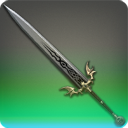
Lockheart: A mighty greatsword of classical design with a double-edged blade tapering from thick to thin from forte to point. This blade can be traced directly to a young banneret, or knight who commands troops, of Ishgard who served House Haillenarte. He learned of the tale of Ser Tryphaniel the Unshod, a lowborn son of Ishgard raised into knighthood for his skill and valor in battle. Ser Tryphaniel was a fervent champion of the people despite his vastly improved fortunes, and upon discovering a priest preying on the impoverished youth of the Brume he slew the priest. His brother knights condemned him, and he gave up his title while chiding the nobility of Ishgard for turning a blind eye to the suffering of the lower classes, leaving the city and becoming a vigilante for the rest of his life. Tryphaniel did not use the same techniques as modern dark knights, but his example went on to inspire them and so he is considered the root of that forbidden order, which protects the weak from the powerful. Inspired, this young banneret took up his blade and went on to follow the teachings of Ser Tryphaniel. This resulted in House Haillenarte imprisoning him when he would not renounce his beliefs, confiscating his mighty greatsword and giving it to the scions of their own house.
Etymology Notes: This blade shares its name with a greatsword from FFXI, and of course with Tifa Lockhart, a main character of FFVII. Tifa was a champion of the people against their oppressors, just as Ser Tryphaniel and the banneret he inspired were, which likely explains the rationale behind this naming.
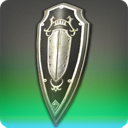
The Vigil Canopus Shield: This is a kite shield, a tapered design of shield commonly used by knights of various civilizations and often decorated with heraldry, either that of a house or individual. This likely was intended to belong to a knight stationed at the Vigil, but it seems to have not yet been decorated with heraldry. Perhaps the Vigil fell before it could be granted or decorated.
Etymology Notes: Canopus is the second brightest star in Earth’s sky, and likely drew its name from one of two origins – either a Grecian origin, in which it referred to the pilot of King Menelaus of Sparta’s ship on the way to the Trojan War, or from an ancient Egyptian port by the same name, which may have been named for the ancient Egyptian spelling of ‘golden earth’ referring to how the sun appeared on the horizon from the port, though the Greeks believed this port was named for their resting place of their own sailor Canopus. I choose to believe that the sailor origin is more likely for this weapon’s name, and it could have referred to a faithful second to a prominent noble and this shield could have been intended as a gift for them.
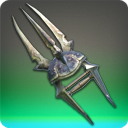
The Jamadhars: These seem to be claws, a form of fist weapon intended to emulate the slashing and raking abilities of beasts while sacrificing the sheer blunt force normally associated with a fist weapon. These weapons are clearly made out of crab shells, a creature not native to Coerthas, and I suspect that these may have been seized in the Autumn War by the forces of House Haillenarte from the Ala Mhigan armies.
Etymology Notes: Jamadhar is an alternative name for the katar, a form of fist weapon originating on the Indian subcontinent. It is this, as well as the coastal nature of Ala Mhigo and the commonality of fist weapons in the kingdom that made me surmise that these weapons came from there.
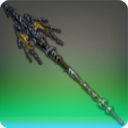
The Wyvern Spear: This is a unique polearm, carved in the shape of a dragon and named for the wyverns, the clade of dragons that specialize in aerial movement. This weapon was almost certainly the chosen arm of a dragoon stationed within the Vigil.
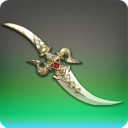
The Jambiyas: Jambiyas are a form of dagger that boasts two wickedly sharp edges, allowing them to be used particularly effectively as a slicing weapon. They are most commonly found on the coasts of Ilsabard, where they often serve as a sign of maturity. These weapons may have been a diplomatic gift to House Haillenarte, either from a Ilsabardian state or group, or from an intermediary like Lominsa, Ul’dah or even Sharlayan.
Etymology Notes: Jambiya is an Arabic term for curved daggers and shortswords.
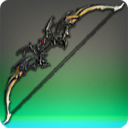
The Shadow Bow: This is a composite bow, a weapon that incorporates both wood and other materials to maximize certain factors of the bow’s performance. Composite bows are particularly difficult to make, and this one seems to employ bone or scale of some kind alongside the standard wood. It seems somewhat evident that this bow incorporates, if not the body parts of a dragon, then elements of their culture, and likely served as a form of weaponized trophy by a veteran fighter against the Horde.
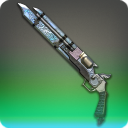
The Blue Steel: Flintlocks like these were innovated by Lominsan gunsmiths using technology already used to develop the city state’s cannons. They involve flint-striking firing mechanisms, though these are vulnerable to water causing malfunctions. A special model of Ishgardian firearm carried specifically by the cannoneers of House Haillenarte, the blue steel line of weapon fused a flintlock with a bayonet, allowing for use in melee and range combat and coining a term, knifelock, to refer to it.
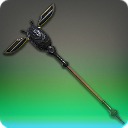
The Keep of Saints: Weapons like these are known as longpoles, thaumaturge focuses that double as polearm weapons used to fend off attacks while still serving as spellcasting foci. The crux of these foci, in longpoles, are typically attached to the end of the stave and often resemble carved vilekin. Saints are a key part of the faith of the Twelve, and nowhere is this more-so than in the Holy See’s church of Halone, dominant in Ishgard. This may have belonged or been dedicated to a saint or saints, and retained as a relic of House Haillenarte or given to the Vigil to boost the morale of its inhabitants.
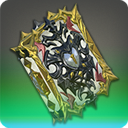
The Ars Almadel: Penned in Ilsabard, this beautiful tome somehow found its way into the possession of an Ishgardian heretic, who was arrested by House Haillenarte and had the tome confiscated from them. This later led to a theory in Ishgard that summoning was a tool of the Dravanian Horde.
Etymology Notes: The Ars Almadel is a section of the Lesser Key of Solomon, a tome dating back to the 17th century created from more ancient resources, that claims to contain information on how to use scrying to contact angels. This may seem incongruous with the heretics of Ishgard, but it is worth noting that the aevis, heretics who consumed dragon blood and transformed into draconic beasts themselves, also draw their name from angels. This may reflect an angelic aspect for dragons in the eyes of the heretics, which would explain the intent of the Ars Almadel; to reach out to, commune with, and perhaps even channel the aether of a dragon.

The Dryad Cane: Fascinating creations, whispering rods such as these are difficult to produce. Made via an extensive and draining series of enchantments, a stave is granted a primitive measure of sentience, although their motor skills are typically restricted only to minor movements of their head. It is easy to see why this would lead to Ishgardians who found such a staff to refer to it as dryad-like.
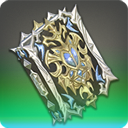
The Ars Notoria: The Ars Notoria is a sibling book of the Ars Almadel, also found on a heretic but this time by a knight of House Durendaire, who was patrolling the tunnels around the Nail, a large spire of rock in Coerthas considered sacred to Halone, pierced by a large shard of Dalamud in the Seventh Umbral Calamity. It is unclear by Ishgardian records if this was the same incident, simply attended by a knight of both houses, or two seperate but obviously linked occasions. Regardless, they demonstrate an intent by the heretics to attempt to branch out into summoning magics.
Etymology Notes: The Ars Notoria is another section of the Lesser Key, apparently used to grant eidetic memory and the ability to instantly learn new information upon encountering it. It is also, interestingly, the oldest part of the Lesser Key by far. In the universe of XIV it may represent a manner in which one might channel their own aether to increase mental acuity, a technique that would be immensely useful to an arcanist of any kind, including a summoner.
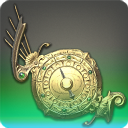
Capella: A planisphere, composed of two rotating metal discs which can be used to predict the disposition of the heavens and set with precious stones that represent the six major constellations of Sharlayan astrology. Capella is particularly ornate, bearing a harp-like construct on its top. Named for a star in the sky, the device is also named for the A capella singing style, a style of song without instrumental backing commonly employed in chapels and small temples across Eorzea. This may represent a connection between Sharlayan and Ishgardian astromancy, aimed by the Sharlayans at appealing to the Ishgardian’s religious preferences. This may have been a part of the famed professor Mace Bryde’s first, failed attempt at converting the city state to Sharlayan’s model of astromancy.
Etymology Notes: Capella is the brightest star in the Auriga constellation, also known as the charioteer. It is commonly known as the goat star, named for the goat Amalthea that nurtured an infant Zeus in Greek myth. It is unclear what relevance this has to FFXIV, besides it being a star to name the astrolabe after.
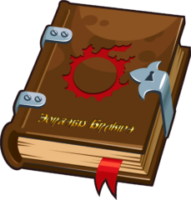



Leave a Reply